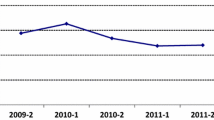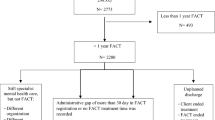Abstract
We determined the proportions of clients treated in Flexible Assertive Community Treatment teams who were unemployed and gained employment and who were employed and lost employment. Secondly, we explored the demographical and clinical factors associated with employment. Data were collected during routine outcome monitoring. We calculated differences in employment rates over a year and explored differences in demographic characteristics at baseline between patient groups. Logistic regression analysis was used to estimate the role of clinical predictor variables on employment status. Over time, 10% remained employed, 5% lost their employment, 3% gained employment and 82% remained unemployed. Clients who found employment were younger, more often male, and had significantly fewer psychosocial problems and a higher subjective quality of life during follow-up than those who remained unemployed. Problems with motivation for treatment at baseline were related to losing employment or remaining unemployed. Better implementation of vocational services is very important for increasing the number of clients gaining employment.
Similar content being viewed by others
References
Allott, K. A., Cotton, S. M., Chinnery, G. L., Baksheev, G. N., Massey, J., Sun, P., … Proffitt, T. M. (2013). The relative contribution of neurocognition and social cognition to 6-month vocational outcomes following Individual Placement and Support in first-episode psychosis. Schizophrenia Research, 150(1), 136–143.
Andresen, R., Caputi, P., & Oades, L. G. (2000). Interrater reliability of the Camberwell assessment of need short appraisal schedule. Australian and New Zealand Journal of Psychiatry, 34(5), 856–861.
Becker, D. R., & Drake, R. E. (2003). A working life for people with severe mental illness. New York: Oxford University Press.
Bevan, S., Gulliford, J., Steadman, K., Taskila, T., Thomas, R., & Moise, A. (2013). Working with schizophrenia: Pathways to employment, recovery & inclusion. Lancaster: The Work Foundation, Part of Lancaster University.
Bond, G. R., & Drake, R. E. (2007). Should we adopt the Dutch version of ACT? Commentary on “FACT: A Dutch version of ACT”. Community Mental Health Journal, 43(4), 435–438.
Bond, G. R., & Drake, R. E. (2008). Predictors of competitive employment among patients with schizophrenia. Current Opinion in Psychiatry, 21(4), 362–369.
Bond, G. R., Drake, R. E., & Becker, D. R. (2012). Generalizability of the Individual Placement and Support (IPS) model of supported employment outside the US. World Psychiatry, 11(1), 32–39.
Bond, G. R., Kim, S. J., Becker, D. R., Swanson, S. J., Drake, R. E., Krzos, I. M., … Frounfelker, R. L. (2015). A controlled trial of supported employment for people with severe mental illness and justice involvement. Psychiatric Services, 66, 1027–1034
Burke-Miller, J. K., Cook, J. A., Grey, D. D., Razzano, L. A., Blyler, C. R., Leff, H. S., … Hoppe, S. K. (2006). Demographic characteristics and employment among people with severe mental illness in a multisite study. Community Mental Health Journal, 42(2), 143–159.
Burns, T., Catty, J., Becker, T., Drake, R. E., Fioritti, A., Knapp, M., … White, S. (2007). The effectiveness of supported employment for people with severe mental illness: A randomised controlled trial. The Lancet, 370(9593), 1146–1152.
Catty, J., Lissouba, P., White, S., Becker, T., Drake, R. E., Fioritti, A., … Van Busschbach, J. (2008). Predictors of employment for people with severe mental illness: Results of an international six-centre randomised controlled trial. The British Journal of Psychiatry, 192(3), 224–231.
Chan, M. (2010). Mental health and development: Targeting people with mental health conditions as a vulnerable group. Geneva: World Health Organization.
Chang, W. C., Tang, J. Y. M., Hui, C. L. M., Chan, S. K. W., Lee, E. H. M., & Chen, E. Y. H. (2014). Clinical and cognitive predictors of vocational outcome in first-episode schizophrenia: A prospective 3 year follow-up study. Psychiatry Research, 220(3), 834–839.
Cohen, J. (1988). Statistical power analysis for the behavioral sciences (2nd edn.). Hillsdale, NJ: L. Erlbaum Associates.
Cook, J. A. (2006). Employment barriers for persons with psychiatric disabilities: Update of a report for the president’s commission. Psychiatric Services, 57(10), 1391–1405.
Cook, J. A., Blyler, C. R., Burke-Miller, J. K., McFarlane, W. R., Leff, H. S., Mueser, K. T., … Donegan, K. (2008). Effectiveness of supported employment for individuals with schizophrenia: Results of a multi-site, randomized trial. Clinical Schizophrenia & Related Psychoses, 2(1), 37–46.
Crowther, R., Marshall, M., Bond, G., & Huxley, P. (2001). Vocational rehabilitation for people with severe mental illness. Cochrane Database of Systematic Reviews. https://doi.org/10.1002/14651858.CD003080.
Drukker, M., Bak, M., Campo, J., Driessen, G., Van Os, J., & Delespaul, P. (2010). The cumulative needs for care monitor: A unique monitoring system in the south of the Netherlands. Social Psychiatry and Psychiatric Epidemiology, 45(4), 475–485.
Drukker, M., van Os, J., Bak, M., à Campo, J., & Delespaul, P. (2010). Systematic monitoring of needs for care and global outcomes in patients with severe mental illness. BMC Psychiatry, 10(1), 1.
Fioritti, A., Burns, T., Hilarion, P., van Weeghel, J., Cappa, C., Suñol, R., & Otto, E. (2014). Individual placement and support in Europe. Psychiatric Rehabilitation Journal, 37(2), 123.
Gilbert, E., & Marwaha, S. (2013). Predictors of employment in bipolar disorder: A systematic review. Journal of Affective Disorders, 145(2), 156–164.
Hajji, K., Chebbi, W., Marrag, I., Soussia, R. B., Younes, S., Zarrouk, L., & Nasr, M. (2015). Sociodemographic and Clinical Profile of Frequent Visitors to Psychiatric Emergency. European Psychiatry, 30, 658.
Hall, P. V., Montgomery, P., Davie, S., Dickins, K., Forchuk, C., Jeng, M. S., … Solomon, M. (2015). Seeking and securing work: Individual-level predictors of employment of psychiatric survivors. Work, 52(1), 91–101.
Holwerda, A., Groothoff, J. W., de Boer, M. R., van der Klink, J. J., & Brouwer, S. (2013). Work-ability assessment in young adults with disabilities applying for disability benefits. Disability and Rehabilitation, 35(6), 498–505.
Kam, S. M., Singh, S. P., & Upthegrove, R. (2015). What needs to follow early intervention? Predictors of relapse and functional recovery following first-episode psychosis. Early Intervention in Psychiatry, 9(4), 279–283.
Killackey, E., Jackson, H. J., & McGorry, P. D. (2008). Vocational intervention in first-episode psychosis: Individual placement and support v. treatment as usual. The British Journal of Psychiatry, 193(2), 114–120.
Kortrijk, H. E. (2013). Use of routine outcome monitoring data for evaluating assertive community treatment (Doctoral dissertation, Erasmus MC: University Medical Center Rotterdam).
Lyons, J. S. (1998). The severity and acuity of psychiatric illness scales: An outcomes-management and decision-support system: Child and adolescent version: Manual. San Antonio: Psychological Corporation.
McQuilken, M., Zahniser, J. H., Novak, J., Starks, R. D., Olmos, A., & Bond, G. R. (2003). The work project survey: Consumer perspectives on work. Journal of Vocational Rehabilitation, 18(1), 59–68.
Michon, H., van Busschbach, J. T., Stant, A. D., van Vugt, M. D., van Weeghel, J., & Kroon, H. (2014). Effectiveness of individual placement and support for people with severe mental illness in the Netherlands: A 30-month randomized controlled trial. Psychiatric Rehabilitation Journal, 37(2), 129.
Mulder, C. L., Jochems, E., & Kortrijk, H. E. (2014). The motivation paradox: Higher psychosocial problem levels in severely mentally ill patients are associated with less motivation for treatment. Social Psychiatry and Psychiatric Epidemiology, 49(4), 541–548.
Mulder, C. L., Koopmans, G. T., & Hengeveld, M. W. (2005). Lack of motivation for treatment in emergency psychiatry patients. Social Psychiatry and Psychiatric Epidemiology, 40(6), 484–488.
Mulder, C. L., Staring, A. B. P., Loos, J., Buwalda, V. J. A., Kuijpers, D., Sytema, S., & Wierdsma, A. I. (2004). De Health of the Nation Outcome Scales (HONOS) als instrument voor ‘routine outcome assessment’. Tijdschrift voor Psychiatrie, 46, 273–284.
Nuechterlein, K. H., Subotnik, K. L., Turner, L. R., Ventura, J., Becker, D. R., & Drake, R. E. (2008). Individual placement and support for individuals with recent-onset schizophrenia: Integrating supported education and supported employment. Psychiatric Rehabilitation Journal, 31(4), 340.
Nugter, M. A., Engelsbel, F., Bähler, M., Keet, R., & van Veldhuizen, R. (2015). Outcomes of Flexible Assertive Community Treatment (FACT) implementation: A prospective real life study. Community Mental Health Journal, 52, 898–907.
Oliver, J. P. J., Huxley, P. J., Priebe, S., & Kaiser, W. (1997). Measuring the quality of life of severely mentally ill people using the Lancashire Quality of Life Profile. Social Psychiatry and Psychiatric Epidemiology, 32(2), 76–83.
Phelan, M., Slade, M., Thornicroft, G., Dunn, G., Holloway, F., Wykes, T., … Hayward, P. (1995). The Camberwell Assessment of Need: The validity and reliability of an instrument to assess the needs of people with severe mental illness. The British Journal of Psychiatry, 167(5), 589–595.
Phillips, B. N., Kaseroff, A. A., Fleming, A. R., & Huck, G. E. (2014). Work-related social skills: Definitions and interventions in public vocational rehabilitation. Rehabilitation Psychology, 59(4), 386.
Pirkis, J. E., Burgess, P. M., Kirk, P. K., Dodson, S., Coombs, T. J., & Williamson, M. K. (2005). A review of the psychometric properties of the Health of the Nation Outcome Scales (HoNOS) family of measures. Health and Quality of Life Outcomes, 3(1), 1.
Priebe, S., Huxley, P., Knight, S., & Evans, S. (1998). Application and results of the Manchester Short Assessment of Quality of Life (MANSA). The International Journal of Social Psychiatry, 45(1), 7–12.
Provencher, H. L., Gregg, R., Mead, S., & Mueser, K. T. (2002). The role of work in the recovery of persons with psychiatric disabilities. Psychiatric Rehabilitation Journal, 26(2), 132.
Rosenheck, R., Leslie, D., Keefe, R., McEvoy, J., Swartz, M., Perkins, D., … Lieberman, J. (2006). Barriers to employment for people with schizophrenia. American Journal of Psychiatry, 163(3), 411–417.
Rothman, K. J. (2002). Measuring interactions. Epidemiology: An introduction (pp. 168–180). Oxford: Oxford University Press.
Ruggeri, M., Leese, M., Thornicroft, G., Bisoffi, G., & Tansella, M. (2000). Definition and prevalence of severe and persistent mental illness. The British Journal of Psychiatry, 177(2), 149–155.
Secker, J., Grove, B., & Seebohm, P. (2001). Challenging barriers to employment, training and education for mental health service users: The service user’s perspective. Journal of Mental Health, 10(4), 395–404.
Shepherd, G., Boardman, J., & Slade, M. (2008). Making recovery a reality (pp. 1–3). London: Sainsbury Centre for Mental Health.
Slade, M., Beck, A., Bindman, J., Thornicroft, G., & Wright, S. (1999). Routine clinical outcome measures for patients with severe mental illness: CANSAS and HoNOS. The British Journal of Psychiatry, 174, 404.
Thomson, R. E. D. A. Jr. (2003). A working life for people with severe mental illness. Oxford: Oxford University Press.
Torrey, E. F. (1995). Surviving schizophrenia: A manual for families, consumers, and providers. New York: HarperPerennial.
Trauer, T., Tobias, G., & Slade, M. (2008). Development and evaluation of a patient-rated version of the Camberwell Assessment of Need Short Appraisal Schedule (CANSAS-P). Community Mental Health Journal, 44(2), 113–124.
Van Os, J., Delespaul, P. A. E. G., Radstake, D. W. S., Hilwig, M. M., Bak, M. L. F. J., & Driessen, G. A. M. (2001). Kernparameters ter evaluatie van een zorgprogramma voor psychotische patiënten. Maandblad voor de Geestelijke Volksgezondheid, 56(10), 952–966.
Van Veldhuizen, J. R. (2007). FACT: A Dutch version of ACT. Community Mental Health Journal, 43(4), 421–433.
Van Veldhuizen, J. R., & Bähler, M. (2013). Manual flexible ACT vision, model, practice and organization, Groningen.
Versantvoort, M., & van Echtelt, P. (2012). Belemmerd aan het werk. Trendrapportage ziekteverzuim, arbeidsongeschiktheid en arbeidsdeelname personen met gezondheidsbeperkingen. Den Haag: Sociaal en Cultureel Planbureau.
Wing, J. K., Beevor, A. S., Curtis, R. H., Park, S. B., Hadden, S., & Burns, A. (1998). Health of the Nation Outcome Scales (HoNOS). Research and development. The British Journal of Psychiatry, 172(1), 11–18.
Acknowledgements
We thank David Alexander who provided medical writing services of on behalf of the investigators listed in this project.
Author information
Authors and Affiliations
Corresponding author
Ethics declarations
Conflict of interest
The authors declare that there are no conflict of interests and no financial interests.
Rights and permissions
About this article
Cite this article
Kortrijk, H.E., Mulder, N.L., Kamperman, A.M. et al. Employment Rates in Flexible Assertive Community Treatment Teams in The Netherlands: An Observational Study. Community Ment Health J 55, 350–359 (2019). https://doi.org/10.1007/s10597-018-0233-0
Received:
Accepted:
Published:
Issue Date:
DOI: https://doi.org/10.1007/s10597-018-0233-0




